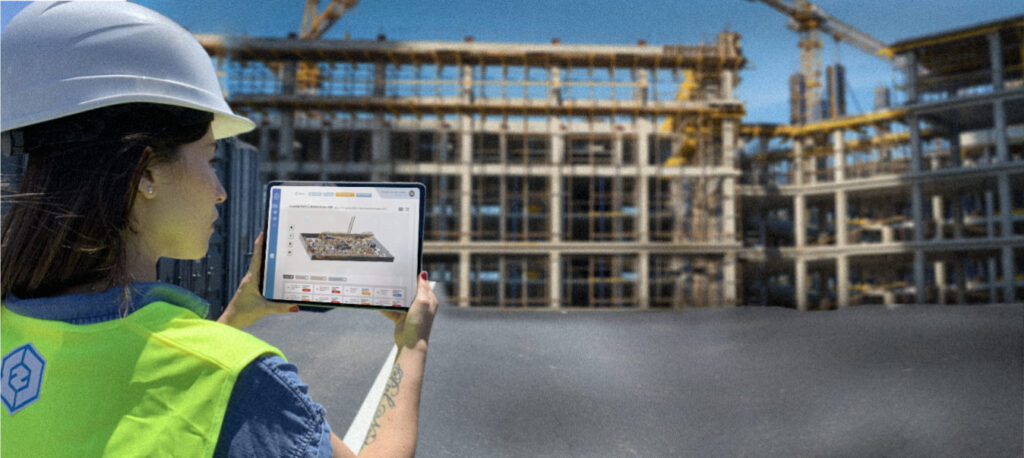BIM (Building Information Modelling) is a construction project management methodology that uses 3D virtual models to plan, design, construct and operate buildings and structures. This model contains detailed information on all aspects of the construction project, such as architectural design, structural engineering, mechanical, electrical and plumbing systems, materials and costs.
To apply it in a construction project, a number of steps must be followed:
- Selection of BIM software and tools: Appropriate BIM software and tools must be selected to allow the project teams to work together on a shared 3D model.
- BIM model creation: Once the appropriate software and tools have been selected, project teams should work together to create the detailed BIM model containing all relevant project information, from architectural design to costing and scheduling.
- Analysis and evaluation: The BIM model allows different construction scenarios to be visualised and evaluated in real time, helping to identify potential problems and solve them before they occur. It also allows detailed analysis of costs, construction times and energy performance.
- Use of the BIM model in construction and operation: Once the BIM model has been created and evaluated, it can be used to guide the construction and operation of the building or structure.
BIM – why use it?
The construction sector was not known for technological advances, quite the contrary, it was a very mature sector and rather reluctant to apply technologies to improve construction projects. The planning and design of buildings was mainly done in 2D using plans and technical drawings, which could lead to errors that resulted in delays and additional costs.

Nowadays, technology has become a basic and essential resource for any project. Tools such as BIM have made construction undergo a significant change and their use has become indispensable:
- 3D virtual models allow you to work on a shared model.
- BIM models contain detailed and accurate information about design, engineering, systems and materials.
- BIM also allows project teams to perform simulations and analyses.
- BIM provides detailed information on costs, materials and construction times.
Benefits of using BIM
- Improved coordination and collaboration between project teams: BIM offers the possibility to work on a common digital model in real time, which facilitates coordination and collaboration between different construction departments. This reduces errors and conflicts between different departments, resulting in increased efficiency and reduced construction time.
- Reduced errors and last-minute changes: Its use makes it possible to detect and fix potential errors and problems in the virtual model before the actual construction. This reduces last-minute changes and the need for rework, which saves time and reduces costs.
- Improved accuracy and quality of construction: Allows project teams to visualise and simulate the project prior to actual construction. This allows potential errors and problems to be detected and corrected prior to actual construction, improving construction accuracy and quality.
- Increased efficiency and productivity: Working on a common virtual model reduces the time and costs associated with planning, design and construction. In addition, BIM reduces the time required for data management and documentation, improving the efficiency and productivity of project teams.
- Improved building lifecycle management: BIM ensures more effective management of the building lifecycle, including planning, design, construction, maintenance and demolition. This enables better decision-making and more effective building maintenance.
How its use can reduce costs and improve efficiency in construction
The use of BIM offers the advantage of reducing costs and can also help to improve the efficiency of projects in different ways:
- Prevention of errors and deviations: BIM makes it possible to detect errors in early phases such as design, which reduces the need for changes and repairs.
- Construction simulation: BIM makes it possible to simulate construction in 3D, which helps to identify bottlenecks and areas of conflict before work starts.
- Improved coordination and communication: BIM improves coordination and communication between the different actors involved in the project, reducing the possibility of delays and errors.
- More accurate planning: BIM allows for more accurate planning of the materials and labour required, reducing the costs associated with overproduction.
BIM in construction project planning – how does it help?
BIM offers many advantages and one of them is to help in the planning process, but how?
- 3D Visualisation: Visualising and simulating the project in 3D makes it possible to detect problems before they occur. This makes it possible to plan for errors and get the project completed as quickly as possible.
- Cost control: It allows accurate tracking of the costs associated with the project so that informed decisions can be made on how to reduce costs and maximise available resources.
- Accurate documentation: BIM can generate accurate and detailed project documentation, including drawings, specifications, bills of materials and task schedules.
- Energy simulation: BIM offers the ability to simulate the energy performance of the building prior to actual construction. This allows decisions to be made on how to maximize the energy efficiency of the building and reduce energy consumption in the long term.
In conclusion, BIM is a very important support tool for project planning. It offers numerous advantages and can help to reduce costs, improve efficiency and productivity. In addition, it saves time and prevents problems and errors, making it key to any design or project.
Key considerations for successful BIM and VDC implementation
To unlock the full potential of VDC, construction companies must focus on a few critical factors:
1. Training and collaboration
Invest in training team members to effectively use VDC tools and foster a culture of collaboration.
2. Choosing the right technology
Select software platforms that integrate seamlessly with BIM and other construction tools.
3. Data management
Ensure data is accurate, secure, and accessible to all stakeholders.
4. Continuous improvement
Regularly evaluate and refine processes to stay ahead in the competitive construction landscape.
Virtual Design and Construction (VDC) is revolutionizing the construction industry by enhancing collaboration, optimizing resources, and delivering high-quality projects efficiently. By integrating Building Information Modeling (BIM) and leveraging advanced digital tools, VDC enables construction teams to excel at every stage of a project’s lifecycle.
In today’s fast-paced environment, adopting VDC isn’t just an option; it’s a necessity for companies looking to digitally transform and thrive in a competitive market. Whether you’re planning your next project or seeking ways to enhance your current processes, VDC offers the tools and insights you need to succeed.

